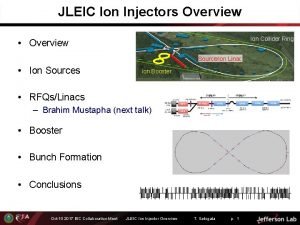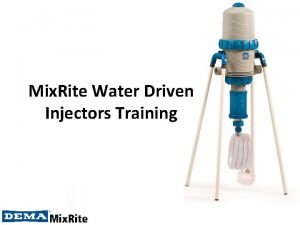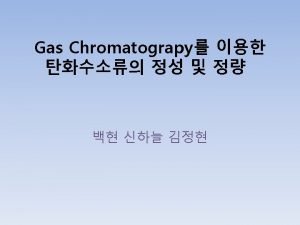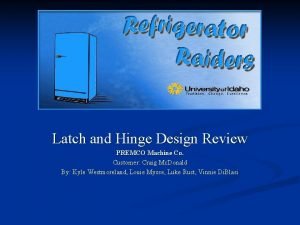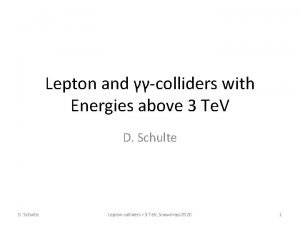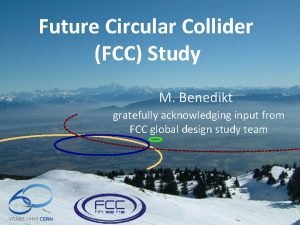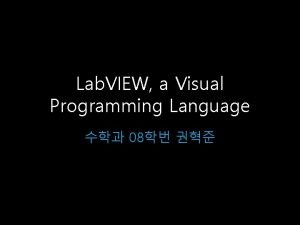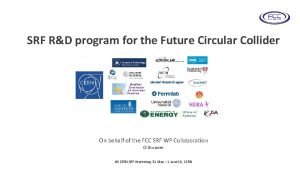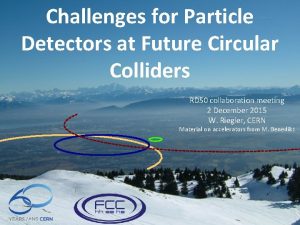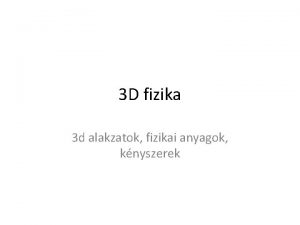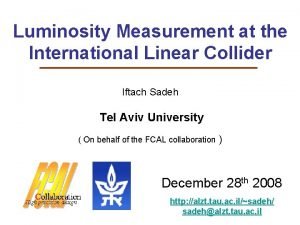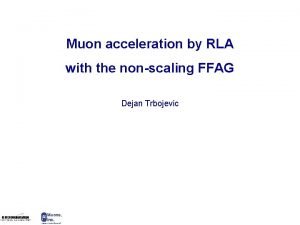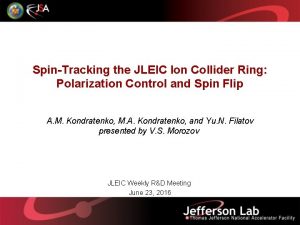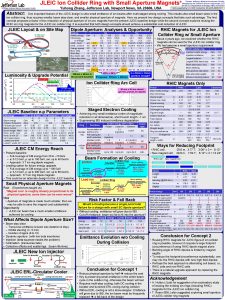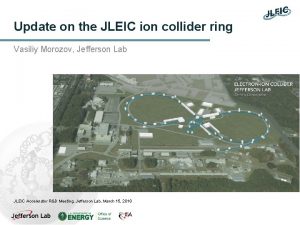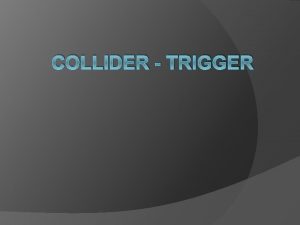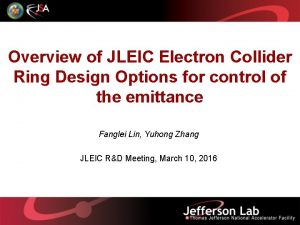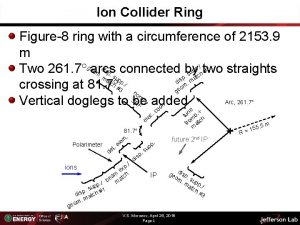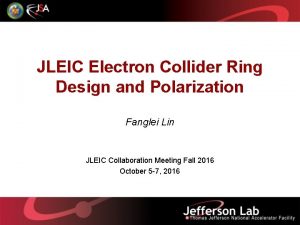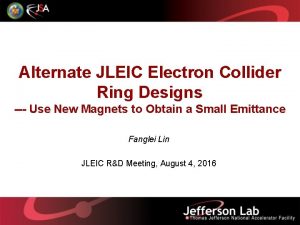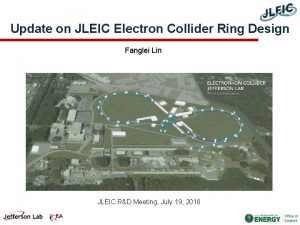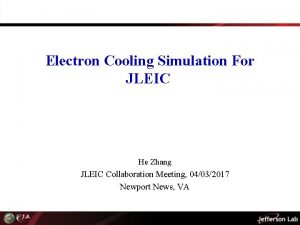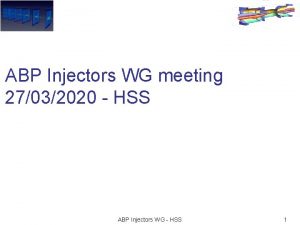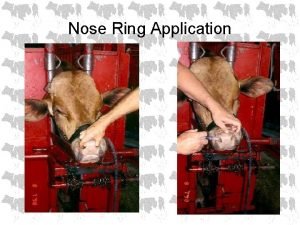JLEIC Ion Injectors Overview Ion Collider Ring Overview













- Slides: 13

JLEIC Ion Injectors Overview Ion Collider Ring • Overview Source/ion Linac • Ion Sources Ion Booster • RFQs/Linacs – Brahim Mustapha (next talk) • Booster • Bunch Formation • Conclusions Oct 10 2017 EIC Collaboration Meet JLEIC Ion Injector Overview T. Satogata p. 1

JLEIC Hadron Beam Complex • Polarized p, d, 3 He; unpolarized heavy ions to 208 Pb • Superferric figure-8 Booster – polarized protons: KE=280 Me. V to 7 Ge. V – 208 Pb+67: KE=100 Me. V/u to 2. 7 Ge. V/u • Source / Linac / Booster needed for ~30 min every 4 -6 hours – Or when beam is aborted or dumped from collider ring • Other time can be spent on tuning and maintenance – And possible future physics programs (e. g. nuclear physics) Ion Collider Ring Source/ion Linac Ion Booster Oct 10 2017 EIC Collaboration Meet JLEIC Ion Injector Overview T. Satogata p. 2

JLEIC “Supercycle” Cooling ions Booster ions Injection electrons Injection ~30 min electrons Collider electron cooler Booster Ramp up Physics Ramp down (ramp) Physics + Top-off (ramp) ~15 min ~240 -360 min (75 -85% of time) CEBAF ~15 min CEBAF =300 -420 min high availability • JLEIC is a new type of hybrid collider – Ion ring injectors are conventional (“long” ion collider stores) – Ion ring electron cooler is a high-power ERL (Benson, Weds) – Electron ring is more like a storage ring light source (Lin, today) • Push towards smaller equilibrium emittance, dynamic aperture • “Top-off” operation requires high injector availability – Both rings require spin lifetime optimization Oct 10 2017 EIC Collaboration Meet JLEIC Ion Injector Overview T. Satogata p. 3

Polarized Ion Source Units JLEIC design ABPIS+ OPPIS* H- Pulse current m. A 2 3. 8 4 (0. 7) Pulse length ms 0. 5 0. 17 (0. 3) Charge per pulse μC 1 0. 65 Protons per pulse 1012 6. 24 4. 03 % 100 91 Polarization 85 Documented performance • ABPIS and OPPIS: existing polarized ion sources – ABPIS provides improved polarized d performance – ABPIS concept exists for polarized He 3, Li • Develop ABPIS to meet JLEIC requirements – Discussing R&D with Dudnikov/Muons Inc/ANL – Reaching out to Julich/TUNL Amy Sy Oct 10 2017 EIC Collaboration Meet JLEIC Ion Injector Overview T. Satogata p. 4

Unpolarized Ion Source Units Charge state JLEIC design EBIS+ ECR* Pb 30+ Au 32+ Pb 27+ Pulse current m. A 1. 3 1. 7 ~0. 5 Pulse length ms 0. 01 0. 02 ~0. 2 Charge per pulse μC 0. 075 0. 1 Ions per pulse 1010 1 ~0. 23 Documented performance • EBIS and ECR: existing unpolarized heavy ion sources – EBIS provides improved intensity performance – Existing EBIS sources meet most JLEIC requirements • Operational EBIS at BNL (RHIC, 2 m), ANL (ATLAS, 1 m) • Low risk: no additional R&D necessary Amy Sy Oct 10 2017 EIC Collaboration Meet JLEIC Ion Injector Overview T. Satogata p. 5

Ion Linac: Layout and Highlights • SRF linac: 135 Me. V p -> 285 Me. V p, 100 Me. V/u 208 Pb 67+ – Extend HWR section with additional cryomodules, same beta RF – Brahim Mustapha, Jacob Heglund (IIT, summer 2017 REU) • Separate light/heavy ion RFQs/LEBTs • Improved NC FODO DTL with IH structure • SRF based on ANL (ATLAS)/FRIB QWR/HWR designs • To be discussed by Brahim in next talk Oct 10 2017 EIC Collaboration Meet JLEIC Ion Injector Overview T. Satogata p. 6

JLEIC Booster: Layout and Parameters Ring circumference: 275 m (Ccollider/8) proton: KE 285 Me. V - 7. 06 Ge. V RF cavity kicker “ 3 T” superferric dipoles ramp rate 1. 0 T/s Crossing angle: 79. 8 deg. extraction • Booster functionality: • – Accumulate linac pulses with DC electron cooling, RF capture – Bunch splitting, longitudinal formation – Extraction/transfer to collider ring – Preserving ion polarization – • figure-8 shape – Imaginary g. T lattice – Space charge dominated: ~0. 2 Oct 10 2017 EIC Collaboration Meet injection Injection: multi-turn 6 D painting (Ed Nissen) – 0. 22 -0. 25 ms long pulses ~180 turns – Proton single pulse charge stripping: 285 Me. V – Ion 28 -pulse drag-and-cool stacking: 100 Me. V/u Extraction: kicker-septum – 300 ns (rise) – 300 ns (flat top) – 300 ns (fall) JLEIC Ion Injector Overview A. Bogacz, IPAC’ 17 WEPVA 040 T. Satogata p. 7

JLEIC Booster Beta Functions Oct 10 2017 EIC Collaboration Meet JLEIC Ion Injector Overview T. Satogata p. 8

JLEIC Booster Dispersion “Negative” dispersion Imaginary transition energy (c. f. J-PARC MR) Oct 10 2017 EIC Collaboration Meet JLEIC Ion Injector Overview T. Satogata p. 9

Booster: protons • H- stripping injection – aperture ~45 p mm-mrad – ~2 x 1012 particles/cycle • 23 k. V h=1 RF capture – – Min bucket height 7 e-3 Capture time 10 -20 ms Bucket area ~6 e. V-s Bunch area ~1 e. V-s 28 cycles = 3 minutes Oct 10 2017 EIC Collaboration Meet Booster f. RF [k. Hz] Booster Brho [T-m] 3. 3 s acceleration time JLEIC Ion Injector Overview T. Satogata p. 10

Booster: lead 208 Pb 67+ Collider 0. 5 A • Linac heavy ion pulses: 0. 5 A, max 250 us (120 Booster turns) – 2 -4 linac pulses of 120+ turn accumulation per Booster cycle – Tradeoff pulse length in cooling accumulation studies Oct 10 2017 EIC Collaboration Meet JLEIC Ion Injector Overview T. Satogata p. 11

JLEIC Bunch Formation Step 6/7. Bucket-to-bucket transfer to the collider ring and BB cooling, repeat 26 times (Nh=28) 4. Accelerate and cool 2. Accumulating coasting beam DC cooler BB cooler DC cooler 3. Capture to bucket 5. Bunch compression to ~56 m 2 x 80 m gaps 1. 2. 3. 4. 5. 6. 7. 8. 9. Multi-turn injection from linac to booster (6 D phase space painting) Capture beam into h=1 bucket (~200 m bunch length) Ramp to 8 Ge. V Compress the bunch length to match ion collider ring RF bucket Bucket-to-bucket transfer, each bucket 80 m (gap between bunches ~24 m, ~80 ns) Cool in ion ring during injection to IBS/LSC limits Repeat step 2 -6 26 times (each cycle ~10 s, total ~6 minimum) Ramp collider ring to collision energy Perform binary bunch splitting up to 7 times to h=3584 (when colliding high energy/low current electron beam, splitting can be reduced to 5 times to h=896), perform bunch length compression and initiate high-energy cooling 10. Manipulate the beam to create/remove several extra empty buckets (476 MHz) in the gap (h=3580 -3588 depending on ion energy, as required by beam synchronization). Jiquan Guo Oct 10 2017 EIC Collaboration Meet JLEIC Ion Injector Overview T. Satogata p. 12

Conclusions • JLEIC ion complex is mostly conventional but still poses challenges – – Polarized ion sources require development (esp. polarized d) Long linac optimization in progress (Brahim et al) Booster injection design and modeling in progress (Ed) Bunch formation strategy: unprecedentedly short bunches (Randy, Jiquan) – Designed to be space charge limited at several stages • Additional work underway to – Document end to end budgets (emittance, intensity) – Develop end to end simulations (particularly Booster) – Develop machine parameter documents (for TDR) Oct 10 2017 EIC Collaboration Meet JLEIC Ion Injector Overview T. Satogata p. 13
